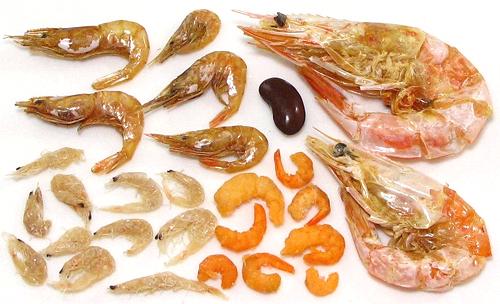 [Hibi (Philippine); Ebi (Indonesia); Ebi (Japan (fresh or dried)); Kung Haeng
(Thai); Tom Kho (Viet)]
[Hibi (Philippine); Ebi (Indonesia); Ebi (Japan (fresh or dried)); Kung Haeng
(Thai); Tom Kho (Viet)]
Dried Shrimp are used throughout Asia, Mexico, Central and South America, much of Africa, and Louisiana in the United States. In most cases they are ground to powder or soaked and mashed to paste for use in recipes, but they may simply be fried whole (often in Africa) and can be eaten as is as a snack (Louisiana).
The photo shows typical examples of dried shrimp found in markets here in Southern California. We have included our infamous red kidney bean for scale.
Camaron Entero: These large shrimp, to the right in the photo, are typical of dried shrimp sold in Mexican and Central and South American markets. They are lightly salted with good shrimp flavor. The photo specimens were purchased from a large multi-ethnic market in Los Angeles in a 1.5 ounce package for 2016 US $2.66 per ounce.
Asian Dried Shrimp: Top left in the photo are dried shrimp of the size and type most found in markets serving Korean, Chinese and Southeast Asian Asian communities. Much smaller ones are also often available. Unless otherwise stated, this is the kind of shrimp to use in Asian recipes. They are usually moderately salted. Soaking them seems to accentuate their prickliness, not soften it. The prickles go from powdery to firm. When used in stocks, these shrimp are usually strained out. I recommend running them to powder in your spice grinder for uses where they will not be removed.
Papery Dried Shrimp: The Chinese name translates to "Shrimp Skins". These always tiny shrimp are shown in the lower left of the photo, and can be found in larger Asian markets serving a Chinese community. They have been boiled before drying and are firm-soft with no prickly parts.
Tom Moi: These tiny dried shrimp from Vietnam (bottom center in photo) have been beheaded, peeled, and possibly dyed before drying. They were dried quite firm, but not totally dry, and were not heavily salted, so they were sold from the frozen cases. Frozen is how you should store them. They have decent, though not intense, shrimp flavor, are lightly chewy, and have no pricklys at all - they can be used whole, and would probably go well with eggs. These were purchased from a large Asian market in Los Angeles (San Gabriel) for 2016 US $6.99 / pound.
More on Shellfish Products
Dried shrimp are strong flavoring ingredients. Not so intense as the shrimp sauces and pastes - but you still need to use them with discretion.
An alternative: if you really want whole shrimp in the recipe, use the "Papery Dried Shrimp" which are not prickly.